In plain sight: Mayan - Lord Pakal's Tomb
They always describe the skeleton as "tall" never in exact
terms and these are scientists!!! And a cone head to boot.
(Yes, a seven foot man is "tall")
The greatest find in Mayan archeology is not to be explained.!!!
I have yet to find a single photo of Pakal's complete skeleton... (Can't
be shown?.) Also described as "tall" without exact length...
Inconsistant age - supposedly 80, but the skeletons teeth looks 40....
No radio carbon dating - no DNA extraction.... He does not fit!!! - he cannot be shown
I'll keep looking, but I defy anyone to find an exact description (or a photo)
of his skeleton. They make a big deal about his teeth but no photographs!
The Mayan pyramid relics located in Palenque ..."King
Pacal regarded as a god and is a giant monster with a height of about 7 ft."
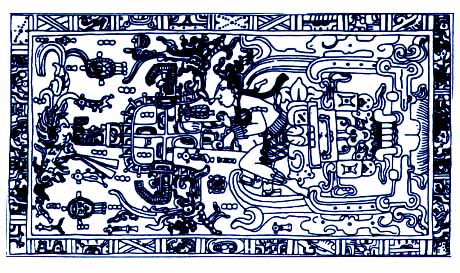
The monolithic sarcophagus is 5 feet 5 inches high, 6 feet 10 inches wide
and 9 feet 9 inches long. The massive, 5 ton cover slab is 12 and one
half feet long by 7 feet inches wide and 8 inches thick..."
http://www.bibliotecapleyades.net/arqueologia/esp_tumba_pacal_3.htm
The sarcophagus and its covering slab were sculptured in place first.
The pyramid and stairs within it were built from the base up after the crypt
was finished. The Temple of the Inscriptions is unique in all Mesoamerica in
this respect.
http://en.wikipedia.org/wiki/K'inich_Janaab'_Pakal
...
His skeletal remains were still lying in his coffin, wearing a jade mask
and bead necklaces, surrounded by sculptures and stucco reliefs depicting the
ruler's transition to divinity and figures from Maya mythology.
That the bones within the tomb are really those of Pakal himself is under
debate due to the fact that the analysis of wear on the skeleton’s
teeth places the age of the owner at death as 40 years younger than Pakal
would’ve been at his death
http://www.bibliotecapleyades.net/egipto/fingerprintgods/fingerprintgods05.htm
Centre-stage, and overlooked by these figures, was a huge monolithic
sarcophagus lidded with a five-ton slab of richly carved stone. Inside
the sarcophagus was a tall skeleton draped with a treasure trove of
jade ornaments.
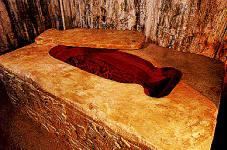 Notice - 9 feet 9 inches long The
top looks about a foot of stone and the bottom looks a foot and a 1/2 so 9'.9''
- 2'.6'' ~= thats still 7' 3'' feet!!!
Notice - 9 feet 9 inches long The
top looks about a foot of stone and the bottom looks a foot and a 1/2 so 9'.9''
- 2'.6'' ~= thats still 7' 3'' feet!!!
A mosaic death mask of 200 fragments of jade was affixed to the front of the
skull. These, supposedly, were the remains of Pacal, a ruler of Palenque in the
seventh century AD.
The inscriptions stated that this monarch had been eighty
years old at the time of his death, but the jade-draped skeleton the
archaeologists found in the sarcophagus appeared to belong to a man half that
age
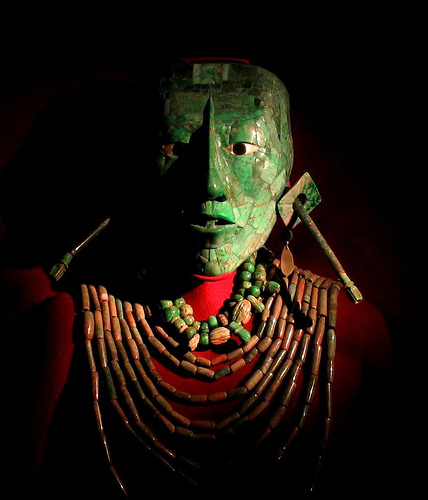
http://mexicanhorse.tripod.com/ruz.htm
...
QUESTIONS WITHOUT ANSWERS YET
1. Did the carbon radioactive test indicate Pakal was 80-year old or 40-year old
at the time of death? Why was the report buried in the archives and not
presented in the archaeological conference?
His stature and strong complexion question the genetic origin of the true
Pakal.
2. What was the cryogenic process that speed up the formation of stalactites
and stalagmites?
The process of these geologic elements is usually very slow, only few milimeters
every 1,000 years and a tomb, approximately 1,300 years old, should not have
shown an advanced process of these underground natural formations.
http://quetzalresistance.blogspot.com/2011/02/quetzal-resistance.html
The Palenque ruins date back to 100 BC to its fall around 800 AD. After its
decline it was absorbed back into the jungle...
Pakal was buried within the Temple of Insciptions. The secret to opening his
tomb—closed off by a stone slab with stone plugs in the holes, which had until
then escaped the attention of archaeologists—was discovered by Mexican
archaeologist Alberto Ruz Lhuillier in 1948. It took four years to clear the
rubble from the stairway leading down to Pakal’s tomb, but was finally
uncovered in 1952.
His skeletal remains were still lying in his coffin, wearing a jade mask and
bead necklaces, surrounded by sculptures and stucco reliefs depicting the
ruler's transition to divinity and figures from Maya Mythology
http://www.legendarytimes.com/forum/viewtopic.php?t=1168
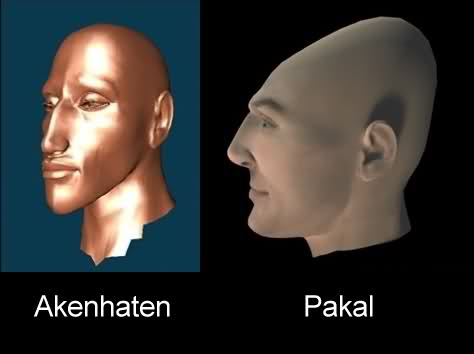
http://www.flickr.com/photos/baggis/3580537357/
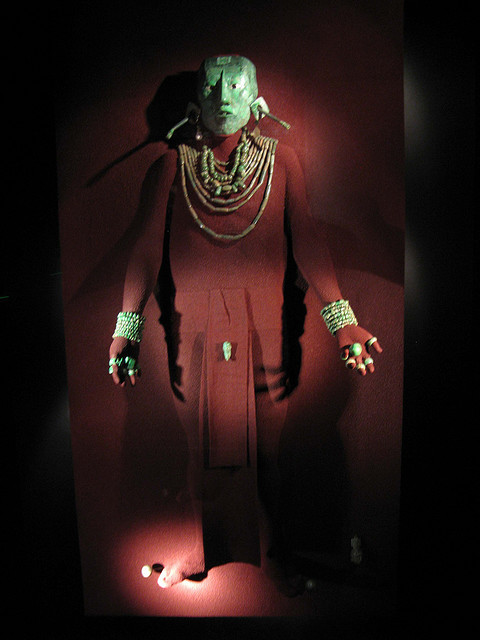
http://www.delange.org/PalenqueTomb/PalenqueTomb.htm
http://pushti-marg.net/bhagwat/palenque.htm
Of Palenque's 500 main buildings, only 34 have been excavated.
However, don't attempt to play Indiana Jones - it is illegal and dangerous.
Oh he died around 600 AD so dna analysis would be great right?
Also he was put into a air tight sarcophagus right? (and 5 ton slab on top
and undisturbed right? well read this, they say the skeleton is junk
now!!!  ? :
? :
(oh and NO PHOTO'S )
http://www.wordtrade.com/history/america/mayaR.htm
...
The decades that have passed since the discovery of the tomb of Janaab' Pakal
have witnessed major advances in our knowledge of the ancient Maya. Significant
developments in epigraphic decipherment and a rapidly growing corpus of new
archaeological and bioanthropological data have restructured the playing field
upon which debates about the ancient Maya are enacted. Whether or not Pakal
would have wished for such attention, he has become a central figure in
debates over the interpretation of Maya epigraphy and history. The identity
of the skeletal remains in the sarcophagus in Palenque is not at issue, but
Pakal's age at death continues to be a subject of debate among Maya specialists.
The chapters in this volume grew out of a multidisciplinary research project
directed by Vera Tiesler and a symposium organized by Vera Tiesler and
Andrea Cucina for the Sixty-eighth Annual Meeting of the Society of American
Archaeology in Milwaukee, Wisconsin, in April 2003. They provide new and
important data on Janaab' Pakal's life and death, drawing upon a
reexamination of his skeletal remains in situ, new laboratory analyses of
associated skeletal material, and comparative data from other archaeological and
bioanthropological studies and from recent advances in Maya epigraphy. Although a
consensus on Pakal's age at death has not been reached, the research and
analyses presented here demonstrate the value of interdisciplinary approaches to
reconstructing the lives of ancient Maya rulers.
...
Even disregarding the fragmentary condition of his remains, Pakal
presents special challenges precisely because of the general age range that he
falls into, whether one accepts the low (40-50 years) or the high estimate (80
years) of his age at death. Skeletal specialists are well aware of the great
difficulty involved in estimating skeletal age in adults, particularly in those
beyond 50 years. Few techniques attempt to enter this territory because of
the great variability and idiosyncratic nature of age changes beyond the 50-year
threshold. Some paleodemographers have developed mathematical approaches to
simulate mortality profiles extending into older age classes. Although these
models may be useful for predicting general tendencies, they are on less firm
ground when applied to a single individual who may show atypical or
inconsistent age indicators. Attempts to age Pakal by comparing his skeletal
age indicators to those of other elite burials at Palenque face the same problem
of imprecision. Despite these major challenges, contributors to this
volume attempt to resolve this and other issues surrounding the life and death
of Pakal by employing some novel approaches.
The condition of Pakal's skeletal remains constitutes one of the principal
problems in estimating his age at death, and one for which little can be
done other than recognizing the limitations inherent in the analysis of fragmentary
and poorly preserved skeletal material.
Poor skeletal preservation is characteristic of the Maya area, as most
contributors to this volume note, and Pakal's remains are no exception to the
rule. Vera Tiesler's recent examination of the skeleton indicates that it
is only about 75 percent complete and poorly preserved. Taphonomic
changes were noted at both the macroscopic and microscopic level, making both
age determination and other analyses problematic, and DNA extraction not
possible. Despite these limitations, however, some observations were
possible on degenerative changes in the vertebral column and joint surfaces of
the appendicular skeleton. Also, Pakal's pubic symphyses and portions of his
auricular surfaces were sufficiently preserved to allow for morphological
observations. Preservation of a rib also was sufficient to attempt age assessment
using histological methods.
...
Vera Tiesler reports on new findings made during a reexamination of Pakal's
skeleton in 1999, including important new information on cranial
modification, childhood health (no evidence of anemia, healed periostitis,
or enamel hypoplasias), and mortuary treatment of Pakal's body.
http://www.moon.com/destinations/chiapas/palenque/palenque-town/palenque-archaeological-zone/temple-the-inscriptions
...
The centerpiece of the chamber is the massive sarcophagus, hewn from a single
stone and topped by a flat four-meter-long (13-foot) five-ton slab of stone.
The slab is beautifully carved with the figure of Pakal in death, surrounded by
monsters, serpents, sun and shell signs, and many more glyphs that recount death
and its passage. The walls of the chamber are decorated with various gods, from
which scientists have deduced a tremendous amount about the Palencanos’
theology.
Working slowly to preserve everything in its pristine state, Ruz didn’t
open the lid of the sarcophagus for six months. It then took a week of
difficult work in the stifling, dust-choked room to finally lift the five-ton
slab. On November 28, 1952, the scientists had their first peek inside. In
the large rectangular sarcophagus they found another, body-shaped sarcophagus,
within which was Pakal’s skeleton, with precious jewelry and special
accoutrements to accompany him on his journey into the next world. A jade mosaic
mask covered the face, under which his teeth had been painted red. (The mask was
exhibited at the Museo Nacional de Antropología in Mexico City until December
24, 1985, when it was stolen along with several other precious historical
artifacts. The mask was recovered in an abandoned house in Acapulco in 1989,
mostly undamaged.)

 Notice - 9 feet 9 inches long The
top looks about a foot of stone and the bottom looks a foot and a 1/2 so 9'.9''
- 2'.6'' ~= thats still 7' 3'' feet!!!
Notice - 9 feet 9 inches long The
top looks about a foot of stone and the bottom looks a foot and a 1/2 so 9'.9''
- 2'.6'' ~= thats still 7' 3'' feet!!!

